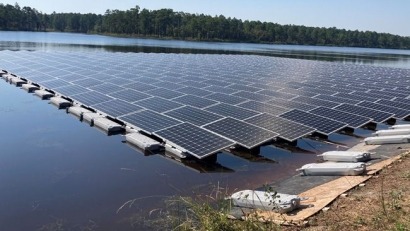
The U.S. Department of Defense is the country’s biggest energy consumer, accounting for around 1% of total energy use in the United States. The U.S. military consumes 77% of the government's energy. This intense fossil fuel usage and emission output make it imperative that the DoD utilizes renewable power sources.
U.S. military renewable energy use will mitigate climate change, improve troop safety and stabilize the military’s budget. It is also necessary for complying with government orders. In 2021, President Biden signed Executive Order 14057, "Catalyzing Clean Energy Industries and Jobs Through Federal Sustainability.” It instructs the national government to use electricity that is 100% free of carbon pollution by 2035.
EO 14057 allows some exemptions for the military, stating any vehicle or aircraft used in tactical and relief operations, combat support or military training may continue to use fossil fuels as necessary. However, the DoD is not exempt regarding energy usage for heating, cooling, lighting and communications on military bases.
The U.S. Armed Forces has already started using renewable energy for transportation and military bases, and it has its sights on more comprehensive programs.
The TGER employs deployable, tactical biorefineries that turn garbage into ethanol, composite gas and benign ash. When soldiers add a small amount of diesel to the mix, they can use the fuel to power a generator that produces electricity. This process cuts down on waste disposal, energy and vehicle fuel costs.
In 2016, the Navy deployed the Great Green Fleet, a year-long event that highlighted the military’s commitment to reducing fossil fuel use. The Great Green Fleet consisted of ships that used hybrid-electric propulsion technology, a 50/50 mix of biofuels and diesel, fuel cells and nuclear power to reduce greenhouse gas emissions and dependence on foreign oil.
Ships that use energy more efficiently can go farther, deliver more firepower and remain at sea longer. It makes them more flexible and brings the military closer to fuel independence. Additionally, efficient energy usage reduces the time ships are tied to oilers, increasing security for Marines involved in refueling. It also takes fuel convoys off the road.
The Air Force produces more carbon emissions than the Army, Marines and Navy combined, with much of this pollution stemming from jet fuel use. Some aircraft now use alternative energy sources such as biofuel blends to reduce emissions.
Under the 2023 National Defense Authorization Act, the DoD must prepare a plan to use more sustainable aviation fuel and begin testing it. The DoD must also identify a refinery that can produce the new biofuel.
The Army is investing in tactical electric vehicles through General Motors Defense, a business unit of GM that focuses on advanced defense mobility requirements. The DoD’s Defense Innovation Unit has already begun testing them. It has also commissioned General Motors to develop a heavy-duty battery pack that can power military vehicles in the field.
As the military starts incorporating more electric vehicles, it will be important that they keep the vehicles up to code with their gasoline fueled counterparts. Military-grade trucks must adhere to rigorous standards like the MIL-STD-1275. This code addresses the voltage, electrical noise and maximum current of parts for ground vehicles. Meanwhile, MIL-STD-810 ensures a military vehicle can handle extreme temperature shifts, high altitude, humidity, sand and vibrations.
Electric vehicles are more powerful than those with internal combustion engines and can accelerate rapidly. They will enable longer travel distances and better performance, and their silence makes them stealthier in the field. Although charging infrastructure must expand before the military can roll out an all-electric tactical fleet, the technology for electrifying vehicles at military bases is already established.
Hydrogen fuel cells are another option for powering military vehicles. The Army has begun experimenting with the Chevrolet Colorado ZH2 fuel cell electric truck, which runs on hydrogen instead of a battery charge. The Air Force also drives hydrogen-fueled nontactical vehicles in Hawaii, indicating hybrid powertrain designs might be viable for tactical vehicles.
The Army installed its first microgrid in 2013 in Fort Bliss, Texas, which includes a solar array, energy storage system and interconnection to the larger energy grid. This installation foreshadowed the solar industry’s explosive growth, with the U.S. solar market on track to quadruple by 2030.
The military has become increasingly reliant on microgrids — it plans to incorporate them in 100% of its bases by 2035, the same year it intends to deploy an all-electric fleet of non-tactical vehicles. Microgrids provide renewable, reliable energy the military can use in case of a widespread power outage. The Army currently has 950 renewable energy projects that supply it with 480 megawatts of power and plans to add 25 new microgrids by 2024.
Other U.S. military renewable energy technology includes solar-powered blankets and backpacks that can recharge the batteries in communications equipment, letting soldiers power their equipment as they walk or rest.
Thermoelectric power is another hypothetical energy source the Army is considering utilizing. The technology works by generating electricity from the small temperature gradient between the skin and surrounding air. As electrons move from the hot side to the cold side of the wearable device — which could be a helmet or clothing — they generate an electric current. This technology would vastly reduce the battery weight a soldier has to carry.
Additionally, the Army has unveiled a floating solar array on Big Muddy Lake at Fort Bragg in North Carolina. It will provide backup power to the nearby training facility during blackouts, as in the case of possible climate-change-related hurricanes in the area. The cooling effect of the water allows the solar farm to generate much more electricity than traditional solar panels.
The United States Armed Forces needds to reduce its dependence on foreign oil. U.S. military renewable energy will help the DoD meet the carbon-pollution-free objectives that Executive Order 14057 lays out. It will also make the Department of Defense more secure, independent and energy efficient, saving money while doing what the military does best — protecting the American people.

